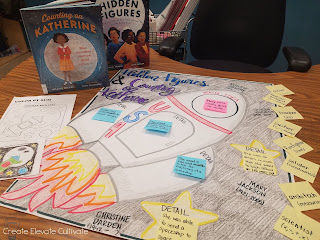There are some wonderful ideas out there floating around
about ways to engage your students in learning. We all know each lesson should
have an engagement component to get our students excited about learning or to
awaken their minds to the content that we will discuss for that day. Well, I want to
share one of my ways to create enthusiasm about a lesson before I even get
to the actual engagement component of the lesson.
I like to use anchor charts. Not just an anchor chart I
pulled out of the drawer and was created a few years ago (definitely have done
that). Not an anchor chart I made last night for the kiddos with all the
information they will need to know for the lesson (guilty of this one also, but
there is a time and place for them). Not an anchor chart that the students and I
create together during an authentic discussion (we do this often to recap our
learning). Instead of those three amazing ways of using an anchor chart, I
choose to use interactive anchor charts for my engagement. The use of these charts
is slightly different than the others.
Here's how:
1. Theme
2. Illustrations
3. Student Comments &
Thoughts
4. Kinesthetic Movement
5. Multipurpose
THEME
These
interactive anchor charts allow you to create a theme for the unit or make a
connection to another content area. When my students started the fraction unit
we were in the beginning of winter, so I came up with, Frosty Fractions.
That got my wheels turning about my first interactive anchor chart of the unit.
I decided it needed to have blank spaces for each representation of a fraction.
I added a snowman illustration to the chart to kick off the theme and boom (Pinterest is also your bestfriend.)! My students and I added
examples of each representation of a fraction as an introduction to my lesson
for each representation. They loved it! Once we were done with our anchor chart,
we kept the theme going using white and blue linking cubes. We used our
imaginations to pretend they were snowflakes throughout the unit. When we
linked them as wholes, we pretended they were snowmen!
ILLUSTRATIONS
One of my
favorite things about interactive anchor charts is the array of illustrations
you can use to capture your students. They also love the images and enjoy admiring them throughout the day. Sometimes I
allow them to give suggestions of illustrations for an upcoming unit.
There are no rules, you can literally be as detailed or vague in your drawings
as you would like! I included a few examples of some interactive anchor charts
I have done this school year. Also check out @cutiepatwoziehq and @thejoysinmrsjohnsonsroom on Instagram.
STUDENT COMMENTS &
THOUGHTS
Another
benefit of using these wonderfully illustrated interactive anchor charts is
capturing student thoughts, connections, and understanding of the concept being
taught. Hearing their thoughts really allows you as the educator to reflect on
what went well, what needs to be retaught, and when it is time to move on from
a skill. The open discussion of a skill also allows other students to be a part
of the discourse and reflect on their own understanding. When we have our
discussions around our interactive anchor chart the length of time varies. When
I use it to model a strategy or representation, we meet for about 5 to 10
minutes, then practice and come back to close out the lesson. The closing is
typically when students will share their understanding of the skill or sequence
the steps for a skill, this can take up to 15 minutes. This is a powerful time in your day to truly listen to
your students. I highly recommend you carve out a few minutes for your students
to reflect on their learning and take note of small group reteaching
opportunities.
Using
interactive anchor charts not only lends itself to illustrations and
accountable talk, but also to the students moving around. Once your students
have gotten used to the idea of these charts, you can encourage them to record
their own thoughts and post them when they are done. A gallery walk of their
responses around the room prior to them all being placed on the interactive
anchor chart is another great way to get the kiddos moving around. Another,
great strategy I use is, act it out. For this, I have a few students volunteer to act
something out. Going back to my fraction unit, for example, I would select 4
boys and 2 girls to come and represent the fraction 2/6. I would not tell the
students the fraction is 2/6, but rather listen to all their fractions about
the group of students and jot down their thoughts on post-its and hang them on the chart. Thinking of a quick way to get your students to
move and be engaged with these interactive anchor charts creates a meaningful
learning experience.
MULTIPURPOSE
Checkout
all the ways you could use an interactive anchor chart in your class tomorrow:
- whole group engagement
- unit/lesson introduction
- unit/lesson review for an assessment
- unit/lesson reflection
- group discussions
- small group instruction
- teach individual skills in a unit
- model strategy or skill
- vocabulary discussion
- text features (diagram with
labels)
Implementing
these FREE interactive anchor charts in your classroom are an easy and quick
way to instantly boost your student engagement and excitement. So, break out
the crayons, markers, colored pencils, and sharpies. You know you need a
coloring break!


No comments
Post a Comment